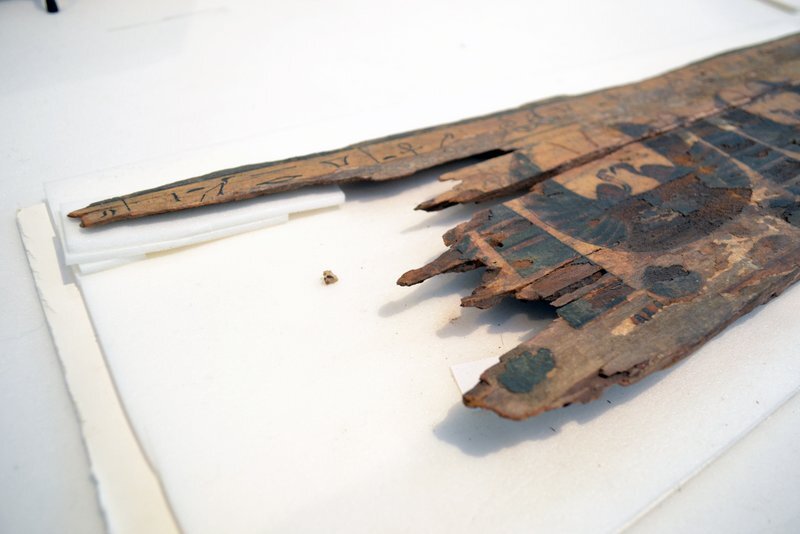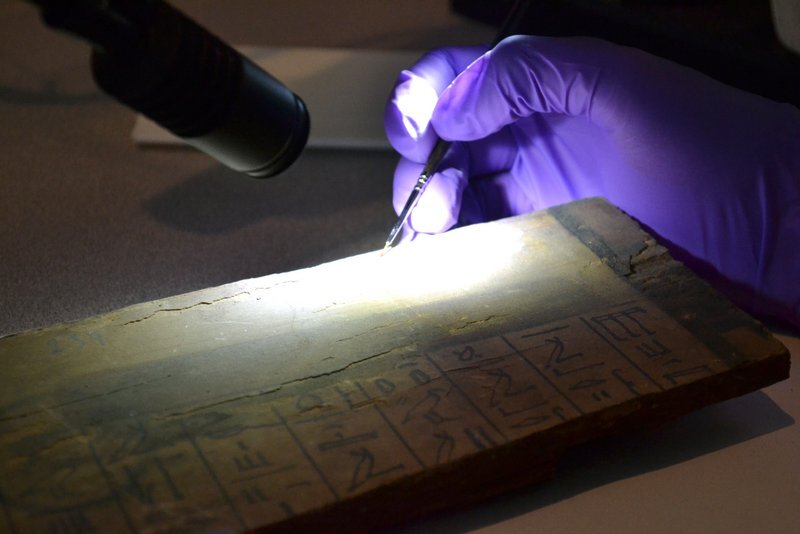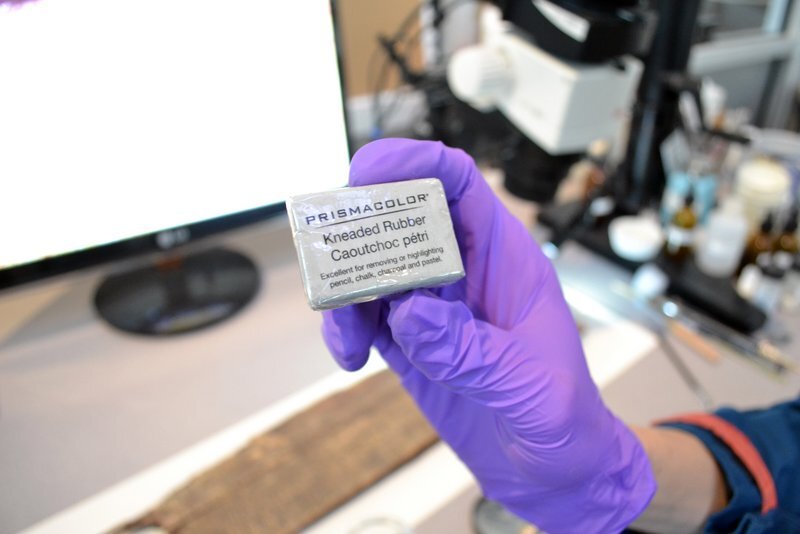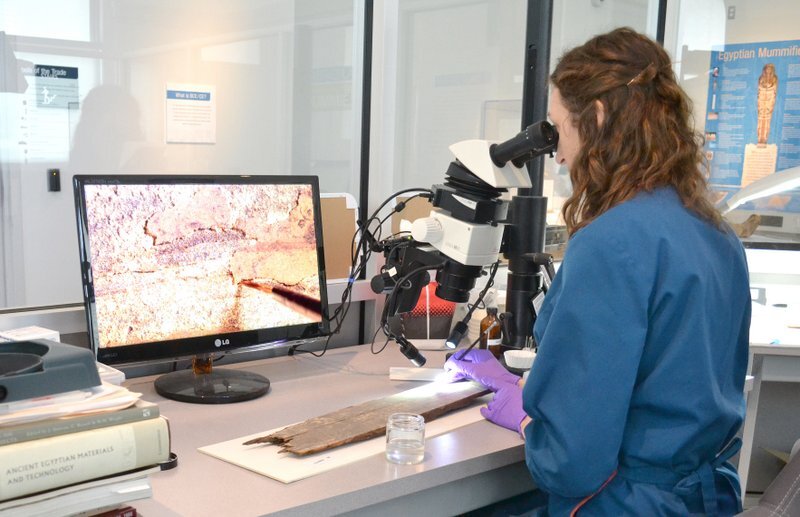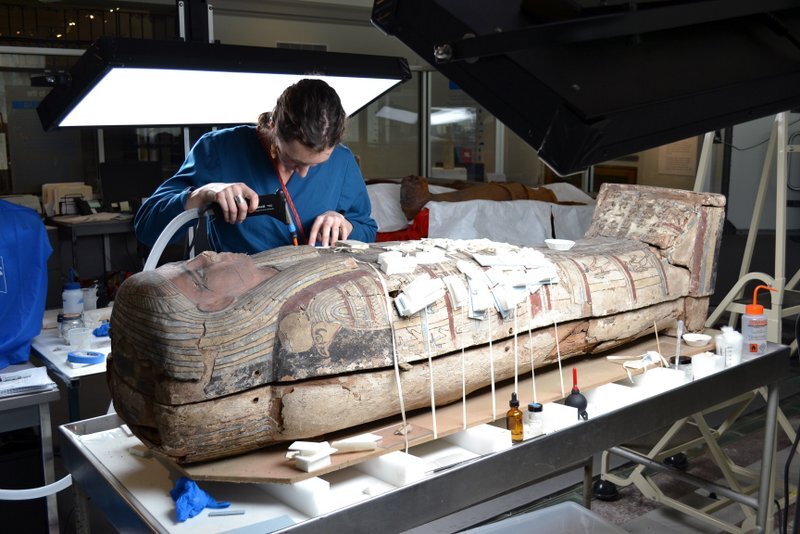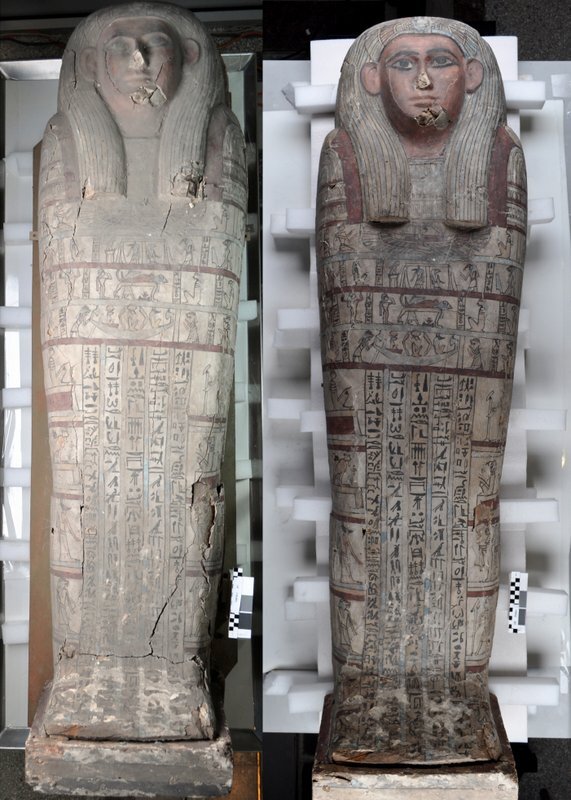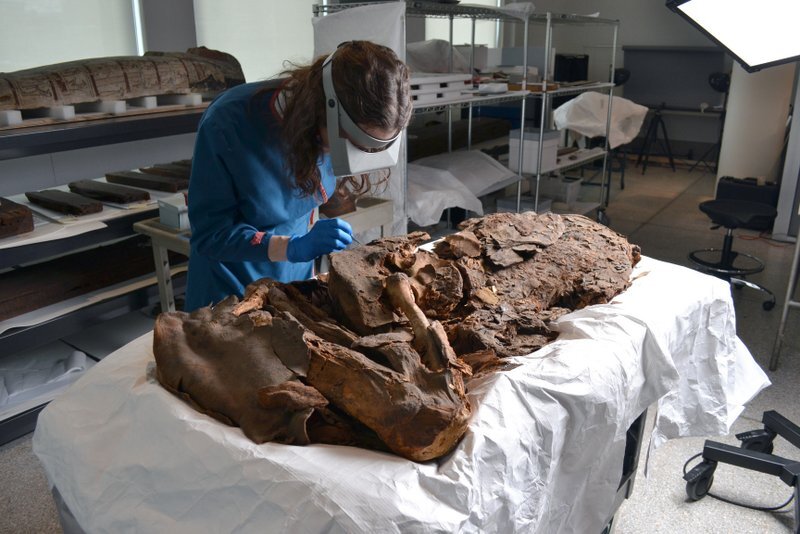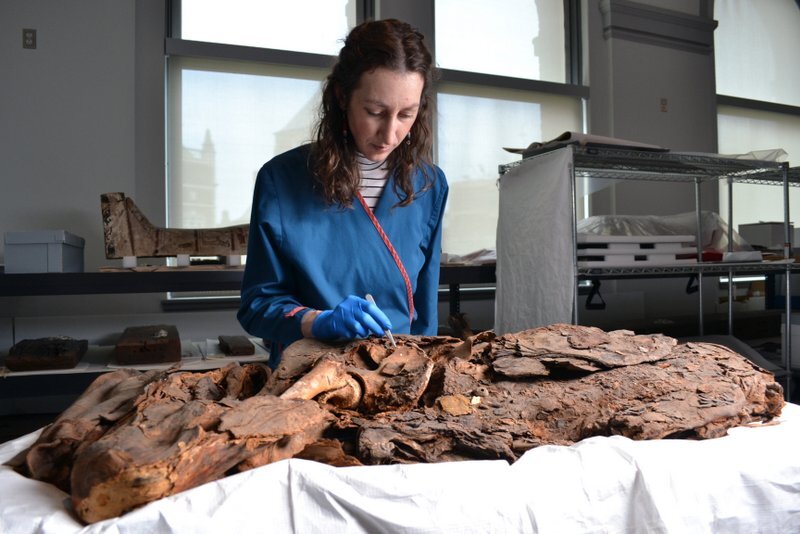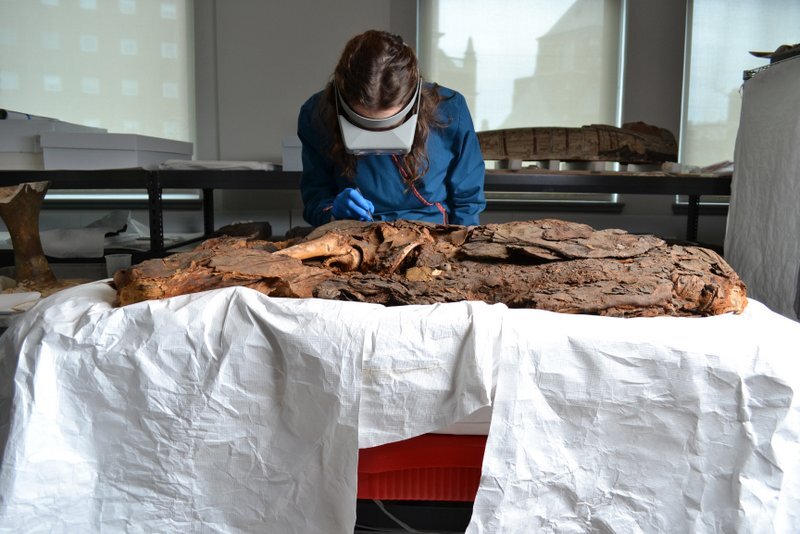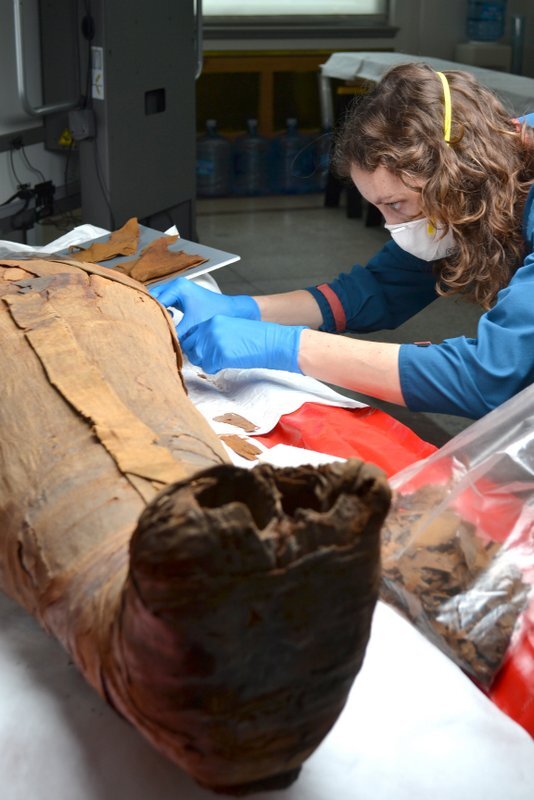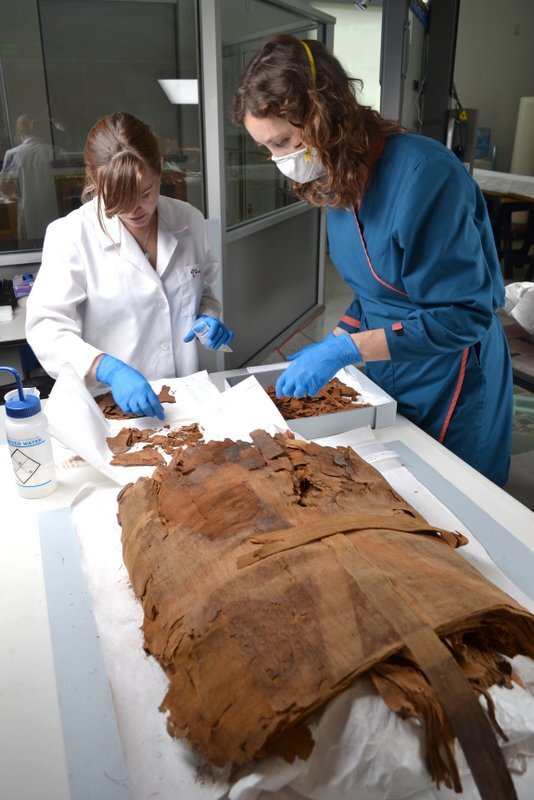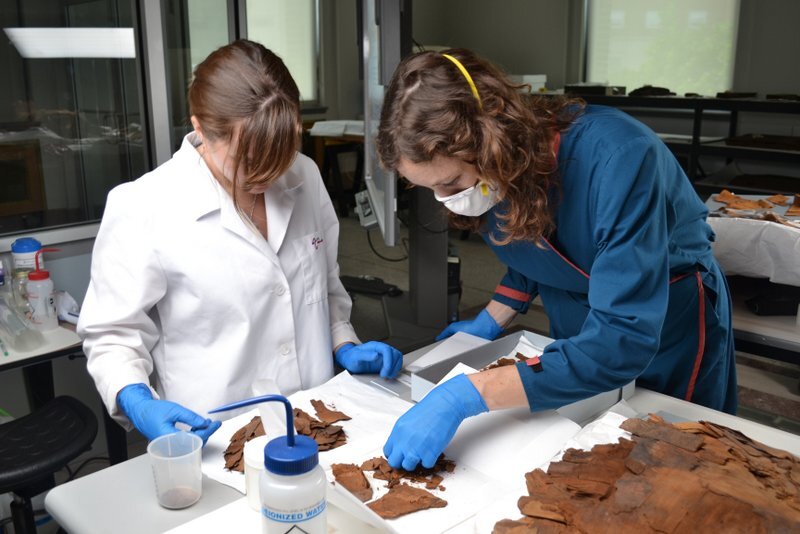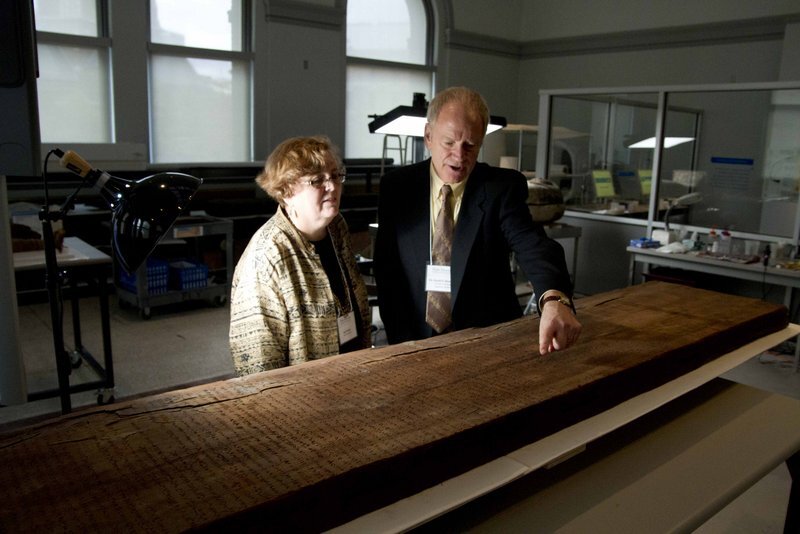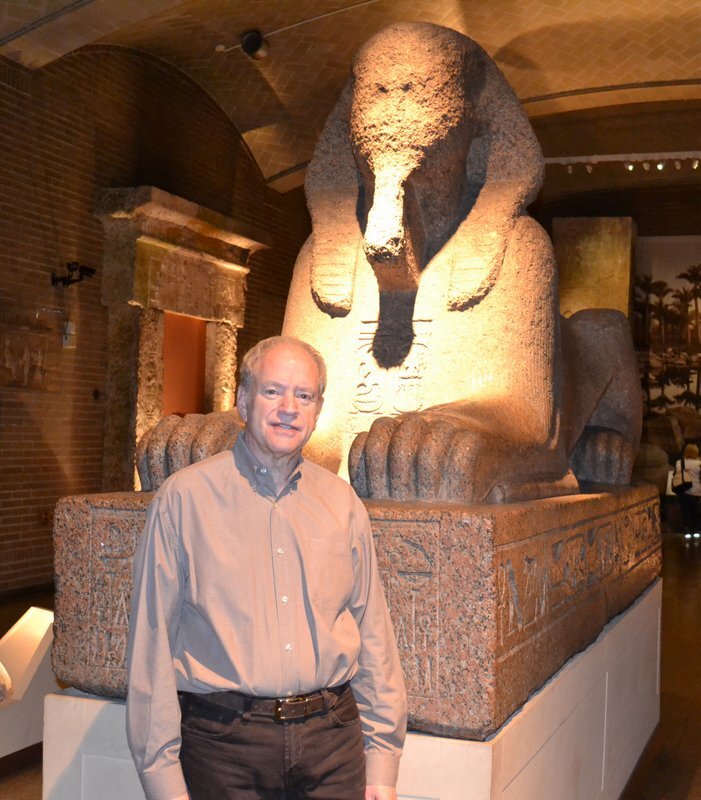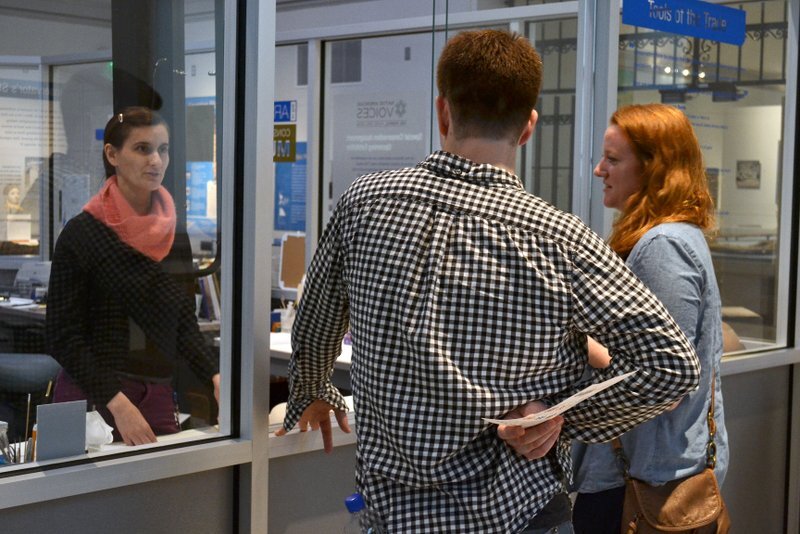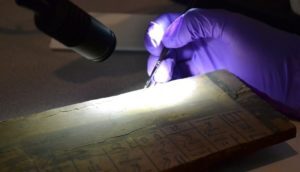
Standing still and quiet behind panes of glass that separate her only inches from an on-looking group of curious visitors, Molly Gleeson focuses intensely on a small, irregular-shaped fragment of ancient wood. Donned in light-weight blue lab attire and blue nitrile gloves, she carefully and meticulously treats and prepares a small piece of wood from a fragmentary coffin excavated in 1901. The coffin remains were brought back from a site in Abydos, Egypt, where the University of Pennsylvania was supporting excavations under the directorship of John Garstang through the Egypt Exploration Fund. It is a site where the Penn Museum has continuously conducted excavations since the 1960s. This small fragment, or ‘board’, as it is called, along with six other boards, is special because it exhibits the remaining traces of painted images and hieroglyphs that once graced the coffin in its full splendor over 4,000 years ago. It was a funerary survivor of Middle Kingdom Egypt. But this piece shows clear signs of termite damage, a destruction that had actually already taken place before the coffin was discovered and excavated. Gleeson’s most immediate objective, after study and research, is to stabilize it from further deterioration, and then restore it as much as possible and apply protective elements for continuing study and future display. It requires cleaning the surface with tools like a kneaded rubber eraser, stabilizing edges where there is paint loss with a 2% solution of methyl cellulose in water, and restoring pieces that had become detached “using a mixture of 5% methyl cellulose and Jade 403, an ethylene vinyl acetate emulsion.”* Such are the tools and techniques of the modern conservationist.
Gleeson is the Rockwell Project Conservator in the University of Pennsylvania Museum of Archaeology and Anthropology’s popular “mummy” lab, otherwise known simply as the Artifact Lab. Today, she and her colleagues are doing things that could be described as small miracles of ‘healing’—what is broken or faded or tainted with the ravages of time can be, in a very real sense, made whole again—at least as much as can be realistically expected. But a hundred years ago, when the coffin fragments were first excavated, the knowledge, skills and equipment required for such operations were not nearly as developed and sophisticated. Gleeson and her team would not be alone in saying that, today, restoration and conservation is an essential extension of the excavating and data collection done in the field, due in no small measure to the advances that have been made in our understanding of how and why ancient things can be preserved for both display and continuing analysis and study.
“Our time in the field is limited by the length of the field season and the funds available to support conservation work on the excavation,” says Gleeson. Weather, political issues, and the nature of the discoveries are additional factors. But “in the lab we have access to microscopes, instruments and equipment (such as x-ray units) that we typically do not have in a field setting.” The tools of the trade include an expanding variety of materials and techniques for examination, treatment and research, including such things as optivisors (magnifying visors), solvents and adhesives, specially tested paper and fabrics, brushes, cotton swabs, scalpels, spatulas, and binocular microscopes. “We also use a polarizing light microscope to examine tiny fragments of objects in order to identify what they’re made of and to identify corrosion and burial products,” Gleeson adds.
These conservators are perhaps most popularly known for their work on the Penn Museum’s collection of Egyptian human and animal mummies, donated to the Museum in years past or acquired from excavations and field expeditions carried out or supported by the University of Pennsylvania prior to 1967. They have thus found themselves working on a range of mummies, from an unknown man mummified during the Third Intermediate Period (ca. 800 BCE) to a small Ibis mummy (a mummified long-legged wading bird), both from storage, just recently unwrapped and repaired. But projects often also include objects related to past expeditions in other parts of the world and associated with other civilizations, such as artifacts from the Penn Museum excavations at Lapithos (in present-day Cyprus) and the historic excavations at the Royal Cemetery of Ur (in present-day Iraq).
In any case, even after the work in the field is finished, the project conservator’s job is an ongoing one, typically extending many years after the initial data collection and analysis has completed its cycle.
_________________________________________
A close-up of fragments from a painted wooden coffin, excavated in 1901 from North Abydos, dating to ancient Egypt’s Middle Kingdom. The wood in these fragments is severely insect-damaged by termites, and paint is actively flaking. Previous treatment on the fragments, using some kind of plaster, is also degrading and falling away—a piece of this plaster is visible at center. Photo: Penn Museum.
__________________________________
Conservator Molly Gleeson applies an adhesive by brush to stabilize the flaking paint on a painted coffin board. After treatment, these boards will be exhibited at the Museum for the first time. Photo: Penn Museum.
_________________________________
Conservators are able to use some simple tools to their advantage. This kneaded rubber eraser will be used to clean the surface of a painted wooden coffin. Photo: Penn Museum.
_____________________________________
Gleeson examines a painted coffin board under a microscope to better understand its manufacture and treatment history. The screen at left is mirrored outside of the lab to offer the public a close view of what she is seeing under the lens. Near the center of the screen, a tiny brush is seen applying small drops of adhesive to the edge of the painted decoration, which will help to stabilize the fragile paint. Photo: Penn Museum.
____________________________________
Gleeson works on realigning sections of the roughly 2,500-year-old coffin of an individual named Tawahibre, who lived during the Late Period in ancient Egypt (558 — 332 BCE). Here, she uses a “Preservation Pencil,” which allows her to direct a stream of humidified air at specific areas of the coffin, relaxing the plaster and wood. After it has moved sufficiently, she will apply pressure to the area to hold everything in place. Photo: Penn Museum.
___________________________________
Before and after: The coffin shown at left before conservation treatment, and again after treatment at right. Photos: Molly Gleeson.
__________________________________
Advancing Knowledge
Conservation in the lab is not only about fixing and preserving things. For centuries, mummies and their associated objects and architectural context have helped to tell the story of ancient Egypt. So in the process of preserving and restoring them, the scientists of the Artifact Lab have discovered new things and raised new questions about ancient Egyptian life and culture.
Gleeson and her colleagues are currently working on an Egyptian Predynastic mummy. Determined to have been a man aged 60 at the time of his death about 6,000 years ago, he was originally donated to the Museum in 1898 by Ethelbert Watts, who was serving as an Assistant American Consul in Cairo at the time. The mummy has been in storage ever since—until 2011, when the mummy was ‘re-discovered’ and brought out of storage by Dr. Jane Hill of Rowan University and her colleague Dr. Maria Rosado.
Nicknamed “Bruce”, he is a curious brown bundle. Within the mass one can see a flexed, articulated skeleton, not unlike other Predynastic mummies.
But Bruce is different.
“He was buried lying on his side, in a flexed position, wrapped in layers of linen, animal skin, and a woven reed mat, and included in the bundle are very finely woven baskets,” says Gleeson. “We are undertaking a technical study of the remains in collaboration with Dr. Hill and plan to create a new storage mount to provide additional protection for the fragile bundle.”
The study could significantly change or add to what we know about ancient Egyptian burials before the pharaohs.
“Everything that we learn from this mummy,” Gleeson continues, “from the way in which his body was prepared, to the materials used in his bundle, will bring new information to light about early technologies and funerary practices in ancient Egypt.”
____________________________________
Above and below: Gleeson examines the oldest mummy in the Penn Museum, a Predynastic mummy that dates to roughly 4000-3600 BCE. Molly is working to identify the type of animal hide in which the mummy is wrapped, as well as the animal hairs used to make the finely woven baskets that are embedded in the “burial bundle.” Photos: Penn Museum.
_____________________________________
It isn’t just conservation and research on the earlier mummies that is breaking new ground and raising new questions. “Bruce” is only one among a number of mummies within the Penn Museum’s collection, considered to be among the most important repositories of ancient Egyptian mummies and funerary materials undergoing active conservation in the U.S. The collection spans thousands of years of Egyptian history. It includes some of the earliest known mummies, which were preserved naturally in time through the effects of the hot desert sand, as well as those that were produced later during the pharaonic periods through artificial methods. “One of the most memorable experiences has been working on a mummy that we call PUM I (Philadelphia University Museum 1),” says Gleeson. PUM I is a man who lived during the Third Intermediate Period (about 850 BCE). Initially donated to the Museum in 1905, the body was autopsied in 1972 and has been in storage ever since. “Working on his remains has uncovered a lot of new information and has challenged previous assumptions,” she continues. “For instance, during the autopsy it was discovered that the body was probably never fully mummified. His internal organs were found during the procedure. As a result his remains are very badly deteriorated under the linen wrappings. Based on this finding, it was assumed that he was likely someone of lower status. But during the recent conservation work, we noted that his remains were wrapped in over 30 layers of linen, and we uncovered and documented traces of a once very elaborate beaded shroud. The fact that he was wrapped in many layers of linen and the presence of this shroud, which would have been expensive and not something that everyone could have afforded, conflicts with the previous assumption about his status. Such findings raise interesting questions about how and why people were making decisions about their burials.”
____________________________________
Gleeson works with PUM 1, whose outer shroud is actively flaking. Here she is shown attempting to reattach a disassociated fragment to the shroud. Photo: Penn Museum.
_________________________________
Above and below: The In the Artifact Lab: Conserving Egyptian Mummies exhibition has also served as a valuable educational setting for budding conservators. Here, Gleeson (right) works with Conservation Intern Anna O’Neill to sort through disassociated fragments of the outer shroud of a mummy before attempting to reattach them. Photos: Penn Museum.
_______________________________
The Big Picture
The Penn Museum’s vast collections have much to do with the institution’s sustained standing at the cutting edge of the science. Since its founding in 1887, the Museum has collected nearly one million objects. Only a fraction of them are exhibited in the Museum’s public gallery spaces. There are hundreds of thousands more stored away, unseen by the public. Much of it awaits the magic of the conservator’s hand before they can be properly exhibited or effectively studied further. So the conservator’s job, in addition to applying an advancing science, is a never-ending one. But it involves much more than spending hours within the exclusive confines of the lab. For David Silverman, the Curator-in-Charge of the museum’s Egyptian collections, it has a lot to do with the lab’s role in presenting the bigger picture of the Egyptian civilization to the visiting public, and it all fits into the Penn Museum’s plans for change over the next few years. This will include conservation work and reinstallation of the museum’s prized throne room of Pharaoh Merenptah’s palace to its full height, something that had been unsuccessfully attempted in the 1930’s because of structural weakness in the floor carrying capacity of the intended gallery space. “Hopefully, the Artifact Lab will become an important part of this project,” he says.
“The conservation of the western wall of the tomb chapel of the treasury official, Kaipure, is the next largest project,” he continues. “Begun in the 1990s, the project was able to conserve the stone blocks and the beautifully carved and painted reliefs on their surfaces. It was exhibited around the country at several museums in the late 1990s, and we await the opportunity of beginning the second half of the project to conserve the remaining walls and then reinstall the entire tomb chapel as it had originally appeared. Other projects include examination and conservation of mummies, papyri, and wooden artifacts.”
Ultimately, it is all about education and the public. After all, the Artifact Lab is part of a museum, and the museum is connected to a major university. “One of the motivations [for establishing the Lab],” says Silverman, “came from our desire to involve the public more in the activities of the museum, explaining the type of work that goes on behind the scenes and why and how we do it. Another was to have the opportunity to work on a greater number and variety of artifacts. As a curator, I welcomed the opportunity to work on material (sarcophagi, papyri, sculpture, mummies, etc.) that the facilities, lighting, climate, and space in storage would not allow. And the public can participate in the action as the events unfold and knowledge is revealed. They become part of the process and are less a passive observer after the fact than a participant who is part of the action.”
___________________________________
Standing behind the glass in the In the Artifact Lab: Conserving Egyptian Mummies, Dr. David Silverman, Curator, Penn Museum Egyptian Section, and Lynn Grant, Penn Museum Head Conservator, examine object #E16218C—a coffin board from the Egyptian site of El-Bersheh. Photo by Steve Minicola, University Communications.
_________________________________
Silverman in the Museum’s Egypt (Sphinx) Gallery. Behind him is a 15-ton red granite Sphinx of Ramesses II, 19th Dynasty, (ca. 1293–1185 BCE), found in Memphis, Egypt. Photo: Penn Museum.
________________________________
For the conservators, interaction with Museum visitors is a major part of the daily routine. Here, Haas Trust Conservator Nina Owczarek answers questions from a group of visitors about her current project during one of the lab’s twice-daily, half-hour “open window” sessions. Photo: Penn Museum.
________________________________
In the Artifact Lab: Conserving Egyptian Mummies can be seen by visitors in the Upper Baugh Pavilion on the 3rd floor of the Penn Museum in Philadelphia. Because it is a working lab, conservators are usually busy focusing on their ongoing projects, but visitors may ask questions weekdays, 11:15 – 11:45 am and 2:00 – 2:30 pm, and weekends, 12:30 – 1:00 pm and 3:30 – 4:00 pm. Readers can also keep up with the latest activities and developments in the Artifact Lab by going to the Artifact Lab Blog.
____________________________________
* From Treating fragments of a Middle Kingdom painted wooden coffin, by Molly Gleeson, In the Artifact Lab Blog, July 6, 2014.

